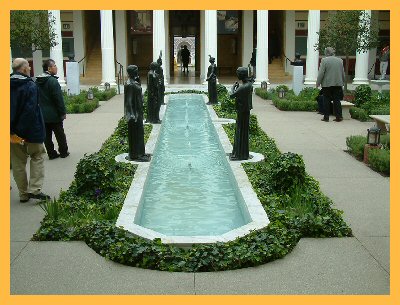 |
|||
 |
|||
 |
|||
 |
|||
 |
|||
 |
|||

by Diane Brady
![]() s my husband drove
our car up the driveway to the villa, I could feel the bumps. The road was
paved with the same kind of large cobblestones the Romans used to pave their
roads. It was bumpy, even for our modern car, and I wondered what it must
have been like, riding in a Roman chariot with its iron-bound wheels and no
springs or shock absorbers.
s my husband drove
our car up the driveway to the villa, I could feel the bumps. The road was
paved with the same kind of large cobblestones the Romans used to pave their
roads. It was bumpy, even for our modern car, and I wondered what it must
have been like, riding in a Roman chariot with its iron-bound wheels and no
springs or shock absorbers.
The J. Paul Getty Trust reopened the Getty Villa in Malibu, California, early
this year. It had been closed nine years for renovation and seismic upgrade.
It returned with a new mission as an educational center and museum dedicated
to the study of the arts and cultures of ancient Greek, Roman and Etruscan
civilizations. In fact, it is the only museum in the United States to be dedicated
entirely to the ancient world.
…
I wondered what it must have been like, riding in a Roman chariot …
Our first view, after walking from the parking garage, was from above the
villa, as if seeing it from the top of an archaeological excavation. It was
as if we were looking at the villa, unearthed for the first time since it
was buried by the eruption of Mt. Vesuvius in 79 A.D. in the seaside city
of Herculaneum.
In fact, the Villa of the Papiri, the model for the Getty Villa, has not
seen the light of day since the eruption. What is known of it is only through
tunneling. It most likely will never be unearthed, as a modern city lies on
top of it.
The first thing we did upon entering the Villa was to pick up the equipment
for the self-guided audio tour. We did, however, also take a guided tour.
An interesting feature of the outer peristyle garden is the decoration consisting
of thousands of painted eggs. There is a small crack in the wall in one place,
and the artist incorporated the crack into one of the eggs, even showing a
bit of it leaking out.
Although an old song says, “it never rains in Southern California,”
it did for us that day. Fortunately, the Getty provided complimentary yellow
umbrellas.
From the gardens we moved to the new amphitheater, which is the way visitors
enter the Villa. It is modern in design, but meant to evoke the feeling of
an ancient Greek amphitheater. Later this summer it will host performances
of ancient Greek and Roman plays—tragedy tomorrow, comedy tonight!
Actually, the first presentation is a tragedy, Hippolytus, by Euripides,
playing on Thursdays, Fridays and Saturdays in September, with previews August
31 through September 2.
Our stomachs told us that it was past our lunchtime, so we headed for the
Café. It gives an entirely new spin on museum food. No ordinary burgers
& fries here. No, no! The food is all Mediterranean inspired, although
they do make a few concessions for the bambini—pasta and meatballs, and
grilled cheese (but it’s on panini with provolone cheese). My husband
had a Tuscan soup (calamari, clams, smoked tomato broth and vegetables over
toasted garlic bread) and I had, from the piattino (small plates) section,
primo piatto (roasted vegetables, marinated olives, soup taster, and grilled
cheese panini).
Admission is free, but tickets are required. You can get them either by phone or online. Attendance is limited and the museum is very popular, so plan a couple of months ahead. Parking is $7, cash only!
The Getty Villa: tel: 310/440-7300; www.getty.edu.
Return to: Current articles, Top, Home.

Inner peristyle garden
Chuck Brady photo
The
outer peristyle garden
Chuck Brady photo
The cracked egg
Chuck Brady photo